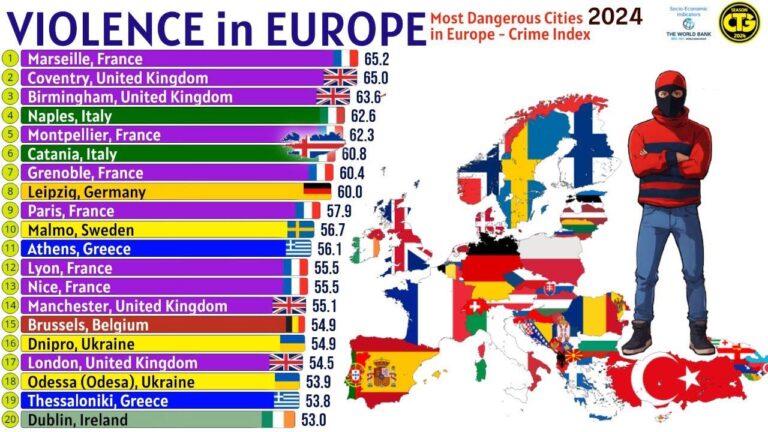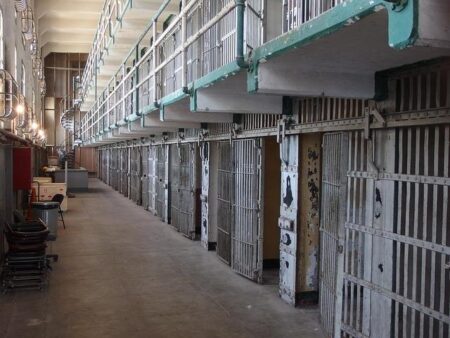In recent years, concerns over urban safety have become a pressing issue for residents and policymakers across Europe. A new report from Visual Capitalist now sheds light on this matter by ranking Europe’s most dangerous cities based on citizens’ firsthand experiences and perceptions. Drawing on extensive data and surveys, the analysis reveals alarming trends in crime rates and public sentiment, highlighting the urban areas where safety remains a critical challenge. This article delves into the findings, providing a comprehensive overview of the cities that top the list and exploring the factors contributing to their reputations as some of Europe’s most perilous places to live.
Europe’s Top Cities Ranked by Resident Safety Concerns
Across Europe, residents voice their safety concerns, shedding light on urban centers where worry is woven into daily life. Cities like Marseille, Naples, and Sofia stand out with the highest levels of unease, driven by factors such as petty crime, social unrest, and insufficient public surveillance. These urban areas struggle to assure their inhabitants, prompting local governments to prioritize enhanced policing and community engagement strategies.
Examining the data further reveals distinct regional patterns. Southern and Eastern European cities report markedly greater apprehension compared to their Northern and Western counterparts, attributed to economic disparities and varying law enforcement effectiveness. Below is a snapshot of the top cities where safety concerns rank the highest, reflecting the pulse of those who live there:
| City | Safety Concern Level | Primary Issues |
|---|---|---|
| Marseille | High | Petty theft, gang activity |
| Naples | High | Organized crime, street violence |
| Sofia | Medium-High | Property crimes, inadequate lighting |
| Berlin | Medium | Pickpocketing, drug-related issues |
| Amsterdam | Medium | Tourist scams, bicycle theft |
- Community policing: A rising trend to bridge gaps between authorities and citizens.
- Urban surveillance: Increasing investment in cameras and technology.
- Public awareness campaigns: Educating residents on preventive measures.
Key Factors Driving Perceptions of Danger in Urban Areas
Urban dwellers’ perceptions of safety are shaped by a mix of visible and intangible elements, each amplifying anxiety to varying degrees. Among the most influential factors are high crime rates, especially violent offenses such as muggings and assaults, which directly erode a feeling of security. Equally critical is the state of public infrastructure—poorly lit streets, neglected parks, and inadequate public transportation contribute to an environment where threats seem more plausible. Additionally, economic disparity and unemployment not only fuel crime but also deepen residents’ sense of vulnerability, creating a vicious cycle of fear and insecurity.
Beyond the tangible issues, social cohesion plays a formidable role in shaping perceptions. Areas marked by social fragmentation or cultural tension often experience heightened suspicion and mistrust among inhabitants. Media coverage also feeds this narrative by disproportionately highlighting negative incidents, skewing public perception in the process. Together, these factors create a complex web that defines the perceived danger levels across Europe’s urban landscapes, ultimately influencing how citizens navigate their daily lives.
- Crime Rates: Violent and property crimes
- Infrastructure Quality: Lighting, sanitation, transportation
- Economic Conditions: Poverty, unemployment
- Social Dynamics: Community trust, cultural cohesion
- Media Influence: Reporting and sensationalism
| Factor | Impact on Perception | Example Cities |
|---|---|---|
| High Crime Rate | Direct increase in fear & avoidance | Naples, Marseille |
| Poor Infrastructure | Enhances feelings of vulnerability | Belgrade, Athens |
| Economic Instability | Triggers social unrest and crime | Valencia, Sofia |
| Low Social Cohesion | Fosters mistrust and anxiety | Brussels, Palermo |
How Crime Rates and Social Issues Shape Citizen Sentiment
Citizens’ perceptions of safety are heavily influenced by both crime rates and a broader spectrum of social issues. Cities burdened with high incidences of violent crimes or organized crime rings often see a sharper decline in public trust toward law enforcement and local governance. However, it‚Äôs not solely the numbers that dictate sentiment‚Äîissues such as unemployment, social inequality, and lack of public services compound feelings of insecurity, creating an environment where fear and dissatisfaction thrive. These factors intermingle, painting a complex portrait of urban vulnerability that goes beyond raw statistics.
The dynamics of fear differ across demographics, with young adults and marginalized communities frequently expressing the deepest concerns. When evaluating danger through citizen eyes, several key social stressors stand out:
- Economic hardship: Poverty and job scarcity intensify feelings of desperation and increase vulnerability to crime.
- Community fragmentation: Weak social bonds and limited neighborhood cohesion exacerbate fears of crime and disorder.
- Lack of trust in institutions: Widespread perception of corruption or inefficiency erodes confidence in public safety measures.
| Social Issue | Impact on Citizen Sentiment |
|---|---|
| High Unemployment | Increases anxiety and perception of crime risk |
| Housing Instability | Leads to feelings of insecurity and alienation |
| Poor Public Services | Reduces faith in local government’s ability to maintain safety |
Policy Recommendations to Improve Safety and Public Confidence
To address the urgent concerns around urban safety, policy-makers must prioritize community engagement and transparent communication channels between citizens and law enforcement. Initiatives such as neighborhood watch programs and public safety forums can empower residents to take an active role in crime prevention while fostering trust in local authorities. Moreover, investing in data-driven policing and real-time crime reporting tools can enhance responsiveness and resource allocation, effectively targeting hotspots and reducing violent incidents.
Equally critical is the implementation of social programs that tackle the root causes of crime, including unemployment, lack of education, and social inequality. Key recommendations include:
- Expanding vocational training and youth apprenticeship opportunities to deter at-risk populations from criminal activity.
- Increasing mental health support and addiction services to address underlying issues contributing to violence.
- Enhancing urban infrastructure and lighting to improve public spaces’ safety perception and actual security.
| Policy Area | Recommended Action | Expected Outcome |
|---|---|---|
| Community Policing | Regular engagement meetings | Increased public trust & cooperation |
| Education & Employment | Job training for youth | Reduced crime rates by 15% |
| Urban Development | Improved street lighting | Lowered nighttime crimes |
The Conclusion
In sum, the Visual Capitalist’s ranking offers a revealing snapshot of urban safety across Europe, highlighting cities where citizens perceive the greatest risks to their security. While certain metropolitan areas continue to grapple with crime and social challenges, the data underscores the importance of targeted policies and community engagement to restore public confidence. As European cities evolve, ongoing monitoring and responsive strategies will be essential to safeguarding residents and fostering safer urban environments for all.




